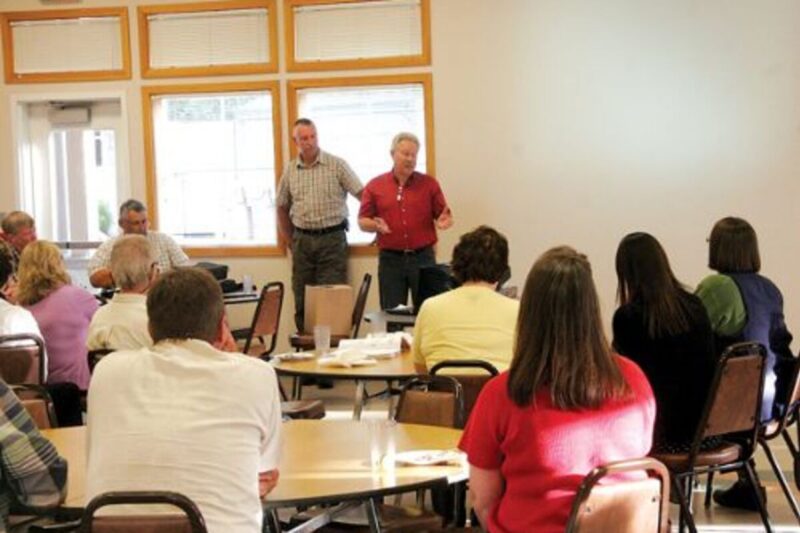Scott Swanson
Board and staff members from Rural Development Initiatives got an up-close-and-personal look at a community on the rise, which they have helped for years, during their annual convention last week at the Community Center.
Since 1991 RDI, an Oregon nonprofit organization that aims to assist rural communities in helping themselves through leadership development, economic vitality, networking, and organizational development, has been working with Sweet Home residents and some 40 people got to see some of the results Monday through Wednesday, June 11-13.
“Many of the things that have happened in this community are directly related to what this organization does,” said Brian Hoffman, economic director for Sweet Home Economic Development Group.
The very existence of SHEDG, after spotted owl protection policies shut down the vast majority of the timber industry in Sweet Home around 1990, is a testimony to RDI’s efforts, said Tim McQueary, former mayor and now an RDI board member.
“They led us through the process of working up a vision for the community and how it would look,” he said. “We lost 1,000 jobs. RDI came to town and that was the time we started SHEDG.”
Before their conference sessions got rolling, the visitors heard from a variety of local community leaders including McQueary, City Manager Craig Martin, Hoffman, County Parks Director Brian Carroll, John Morrison of the Visit Linn Coalition, Cascade Timber Consulting President Dave Furtwangler and Alex Paul, former publisher of The New Era.
They also watched as Joanne McQueary, representing the Oregon Community Foundation, presented RDI with a $30,000 grant.
McQueary, who organized the welcome and a bus tour of Sweet Home that followed, said she wanted RDI to see the “results of their work.
“I wanted them to see a community that has a lot of vitality and much of it is directly related to their efforts.
“I simply connect the people. I picked out a small handful of folks who represent their community – it could have been 200 or more – to review that history, what’s happened from the 1980s until now.”
Paul gave the visitors some historical perspective, noting that the listing of the spotted owl as a threatened species reduced the timber harvest in the Sweet Home Ranger District from approximately 80 million board feet per year to less than 10 million, forcing the closures of most mills in town.
Tim McQueary said he knew former loggers who were retrained and got jobs in factories, “but they didn’t last at that very long. They missed the forest and the fresh air. They moved to Alaska or Canada or somewhere where they can have some semblance of the life they were raised in.”
Paul said he learned about Sweet Home’s resilience and volunteer spirit early on after arriving here in 1985. He described how the Oregon Jamboree was founded by Marge Geil and Leslie Anke and a host of volunteers, how the Community Center, fire and police stations were built, how the high school and the elementary schools have been remodeled, how City Hall has been upgraded, how the Edgewater Marina was built.
He said that, despite the fact that many local residents are now forced to work out of town, “if you go from this building, out to the baseball fields, you’ll see crowds of kids out there, all coached by volunteers,” he said. “There’s 60 volunteers in the fire department.”
Martin reviewed key portions of the vision statement developed with RDI’s help in 1993.
Morrison, a Brownsville resident who is a leader of the Visit Linn Coalition, an ad hoc group of city officials and private citizens interested in boosting tourist traffic to the area, and Carroll both talked about the importance of tourism and the recreational offerings of the Sweet Home area, which have led to big growth in the parks department.
Carroll said his department’s annual revenue has increased from $230,000, when he arrived 15 years ago, to $1.2 million last year and that it is essentially self-sustaining. He cited the recent construction of River Bend Campground, the first new county park in 25 years, the acquisition of Clear Lake Resort, and the cooperation with the U.S. Forest Service in managing its campgrounds along Highway 20, as contributors to that growth.
Future problems include development of improved facilities in the Green Peter area and the possible acquisition of the Cascadia Cave Native American historical site.
He said Green Peter Lake and the Quartzville Corridor are comparable to what Detroit or the McKenzie River have to offer, “but without development.”
“We’re trying to take into account what the community wants,” he said. “They know what Detroit and the McKenzie River have to offer. We’re looking to build something that Sweet Home will have to offer.”
Martin added: “People say recreation is in our back yard; here we say it’s out our back door.”
Furtwangler described how his company, which employs nearly 250 people directly or indirectly in Sweet Home and manages 140,000 acres of timber for the Hill family of Minnesota, described CTC’s involvement in the community, including its donation of the land for River Bend.
He noted that CTC each year provides a giant Christmas tree to the Hallmark Company of Kansas City, Mo., and he and company manager Milt Moran presented the visitors with carved Christmas ornaments which Hallmark makes from the tree after the holiday season ends, and sells for charitable purposes.





